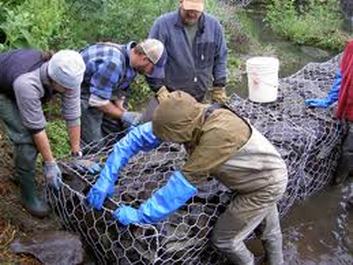A Case for Good Dams
Rancho San Bernadino, Sonora, Mexico, along US border
Eventually, these check dams will disappear beneath the soil and plant communities, as all good dams should…”
Until recently, I thought only beavers could build beneficial dams. Valer Austin convinced me, as well as Oprah, otherwise. On many formerly eroded and degraded hillsides on Cuenca Los Ojos lands, Valer and Josiah Austin and their restoration teams have built gabions, small check dams,to slow water run-off and allow soil to rebuild. At their showpiece restoration site, San Bernadino Ranch, on the south side of the Arizona/Sonora border, they have also built larger earthen dams, to accrete soil and vegetation layers back up to near their original levels.
The biggest dam is more than a hundred yards wide and, including the spillway, more than 20 feet high – to match the arroyo down-cutting resulting from decades of heavy grazing by cows. The dams are not pretty, being essentially caged rocks, but they do their jobs well. Layers of sediment accumulate behind the check dams, more caged rocks are piled atop, and gradually the ground returns to its natural levels. Eventually, these check dams will disappear beneath the soil and plant communities, as all good dams should.
Here in the San Bernadino Valley, part of the Sonoran Desert, in the midst of a decadal drought, water and grass and riparian forests seem everywhere. Look past CLO lands to other private lands, however, and you see the barren grounds and deeply incised arroyos typical of much of the overgrazed Southwest. Across much of their 200,000+ acres of lands, CLO has not only removed livestock and built small check dams, they have also restored native grasses and trees, removed exotic species, assisted imperiled fish and frogs, and augmented deer numbers so native predator populations can rebound. With their backs against the wall, literally, they’ve asked Homeland Security to use only vehicle barricades (which animals can get through), not the massive metal walls being erected many places, where the border runs along their lands. The results are green and lush.
As a foundation, Cuenca Los Ojos has already invested about as much money in direct land conservation and restoration it can. The Austins have given their wealth to the land. So Valer and Josiah are not so much looking to acquire new lands to restore as they are to finish the restoration work on the extensive core areas they’ve already assembled, ensure that those lands have perpetual protection (difficult to arrange in Mexico, where public lands are scarce and conservation agreements generally expire with the owners’ passing), raise an endowment for CLO lands, and pass on the information they’ve gained from nearly three decades of restoration work. David Hodges, former director of Sky Islands Alliance, now works for CLO and is helping arrange talks and visits on restoration of Southwestern watersheds, and managing university research programs on CLO lands – whose wildness and recovery make them ideal places for research.
Big dams are usually bad, but the Austins’ use of many small check dams and a few larger earthen dams on their lands in Arizona and Sonora has proved that active restoration can work and watersheds can be brought back to health. The countless native fish we saw in Silver Creek and the numerous birds flitting about the gallery forests were testament to the power of a few determined individuals to do great good and to the resilience of Nature, if we give natural processes and native species ample space and occasionally lend a helping hand.
As I bid Valer and Josiah and David grateful farewells, I urged them to get out and talk in public as much as possible and share their inspiring places with as many young people as they can.
For the Wild,
John

